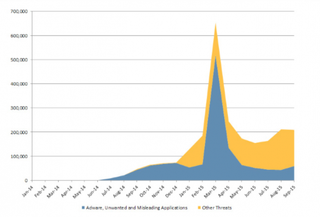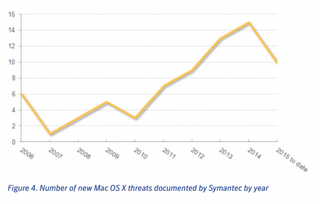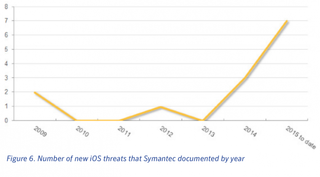Apple OS X, iOS Malware on Rise, Says Symantec
While Apple has long touted the superior security of its computers and smartphones, the rising popularity of the company's devices has been met with a spike in malware attacks and threats. A new report from the Mountain View, California-based security firm Symantec details how threats to the desktop platform OS X rose by 15 percent in 2014, that adware is becoming more prevalent on Mac computers and that even non-jailbroken iOS devices are facing a rise in threats.

Image: guteksk7/Shutterstock
From 2006 to 2011, Symantec documented between one and seven new threats to OS X annually, but from 2011 to today, that number rose as high as 15 per year. And while conventional wisdom assumes iPhones will be safe as long as owners don’t jailbreak their devices, Symantec’s report explains that 30 percent of known threats to iOS can affect devices running unaltered versions of the mobile operating system.
MORE: Best Mac Antivirus Software
The report also details how adware and other potentially unwanted applications have become the most common, if not the most dangerous, threats to Macs, and how they became more widespread after the summer of 2014. Symantec detected more than 600,000 installations of such software in March 2015, and this statistic has been stuck at above 150,000 since that time, higher than where it was for all of 2014.

The rise of adware and potentially unwanted application detections from 2014 to Sept. 2015. Image: Symantec
Symantec said that the walled-garden approach for software installation imposed by the Mac App Store (MAS) may help protect users from becoming infected with malware, but that this protection comes at the cost of Apple controlling what users can download. The Symantec report also notes that there are still security flaws in Gatekeeper, the application that stops Macs from installing software that didn’t come from the MAS.
Stay in the know with Laptop Mag
Get our in-depth reviews, helpful tips, great deals, and the biggest news stories delivered to your inbox.
While this is bad news for Mac users, the number of new threats has gone down since 2014, and detected malware infections and security risks have declined since March. Still, we recommend that Mac users install antivirus software for their own protection, since their computers are clearly far from safe.

Image: Symantec
According to the Symantec report, while there are generally more known vulnerabilities for Windows PCs than for Macs, the two briefly swapped spots when a nadir in discovered Windows vulnerabilities in 2014 synced up with a rise in OS X security flaws.

Symantec noted that Apple's mobile platform iOS has also been under greater attack in recent years. After 2013, known, the number of active threats to iPhones and iPads took a sharp uptick, and currently stand at seven. Symantec notes that an impostor version of Apple's Xcode developer tool kit — called XcodeGhost — allowed for existing apps distributed by Apple to be tainted and steal user information, and this hit both iOS and OS X. Abuse of Apple's developer and enterprise licenses allowed other malicious apps to be installed on non-jailbroken iOS devices.
- 12 Computer Security Mistakes You’re Probably Making
- Best Antivirus Protection for PC, Mac and Android
- Mobile Security Guide: Everything You Need to Know
